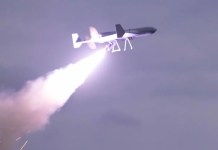The U.S. Air Force has tested the new F-15E electronic warfare upgrade package EPAWSS during a novel exercise conducted on 17th November, hinting at the system’s development process and operationalization.
China Looks To Create An Army Of Stealth Fighter Jets With New “Metamaterial” Element
The exercise, named Large Force Test Events (LFTE) 20.03 integrated ten weapons systems, including the F-35, F-22, F-15E, F-16, A-10, E/A-18G, HH-60G, EC-130H, KC-46, and KC-135, from the U.S. Air Force and U.S. Navy on November 17, 2020, to test four Tactics Improvement Proposals, known as TIPs, as well as various high priority tests. The exercise ensured the interoperability among the forces and refine electronic warfare tactics in a contested environment.
“We owe it to the warfighter to test like we fight,” said Col Ryan Messer, commander, 53rd Wing. “It is only through realistic, massed force, fully integrated, high threat density environments that we can do that, and LFTEs are essential stepping stone events as we formalize what the future of testing like we fight looks like.”
According to the press release, the F-15E Eagle Passive/Active Warning Survivability System (EPAWSS) was one of the ‘prioritized’ tests, along with the F-16’s new AN/APG-83 radar, and counter-tactics against enemy Passive Detection Systems.
The EPAWSS is a major electronic warfare upgrade for the USAF’s F-15E Strike Eagle fleet, which would significantly enhance its capabilities as a true 4.5 generation fighter. It still serves as the service’s primary multirole platform along with the single-engine F-16s.
According to BAE Systems, the EPAWSS offers ‘fully integrated radar warning, geo-location, situational awareness, and self-protection solutions to detect and defeat surface and airborne threats in signal-dense contested and highly contested environments.
Five NATO Nations Collaborate To Develop Next-Generation Multi-Role Helicopter
Equipped with advanced electronic countermeasures, it enables deeper penetration against modern integrated air defense systems, providing rapid response capabilities to protect the aircrew.’
The F-15E was pictured while refueling from a KC-46A tanker and wore ‘OT’ tail code associated with the Air Force’s 53rd Wing, responsible for testing and evaluation of new equipment and systems, including electronic warfare suites.
“For the Strike Eagle aircrew, this means a more timely and accurate warning of ground-based radio-frequency (RF) threats, including their specific type and location, as accurate bearings for airborne threats, both RF and infrared in nature. Armed with this additional situational awareness, the crew should be able to avoid, engage, or negate the threat. As well as alerting the crew to the threats as a defensive system, EPAWSS is able to target these threats offensively, employing countermeasures,” mentions Thomas Newdick in his article in TheDrive.
The F-15E Strike Eagle is the American all-weather multirole strike fighter designed in the 80s to carry out long-range strike missions, high-speed interdictions, without relying on escort or dedicated electronic warfare aircraft. The Strike Eagle was developed from the original F-15 Eagle which made its first flight in 1972.
China Looks To Create An Army Of Stealth Fighter Jets With New “Metamaterial” Element
In American service, The aircraft (F-15E) has seen operational deployment in almost all of the wars fought by the United States since the 80s, including Iraq, Balkans, Afghanistan, Libya, and over the Middle East supporting Operation Inherent Resolve against the Islamic State.
The aircraft is operated by Israel, with which it has seen an impressive operational record due to the hostile environment it is deployed in. Saudi Arabia has also used the aircraft in its intervention in Yemen.





